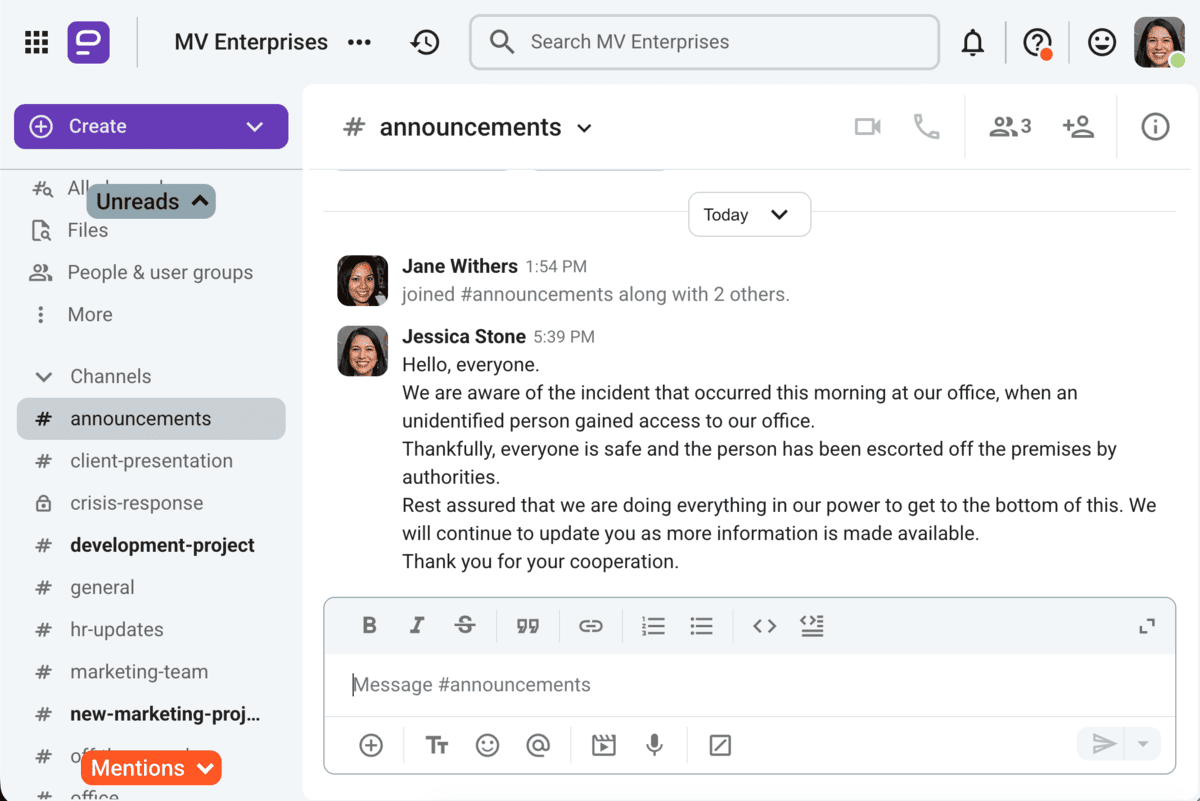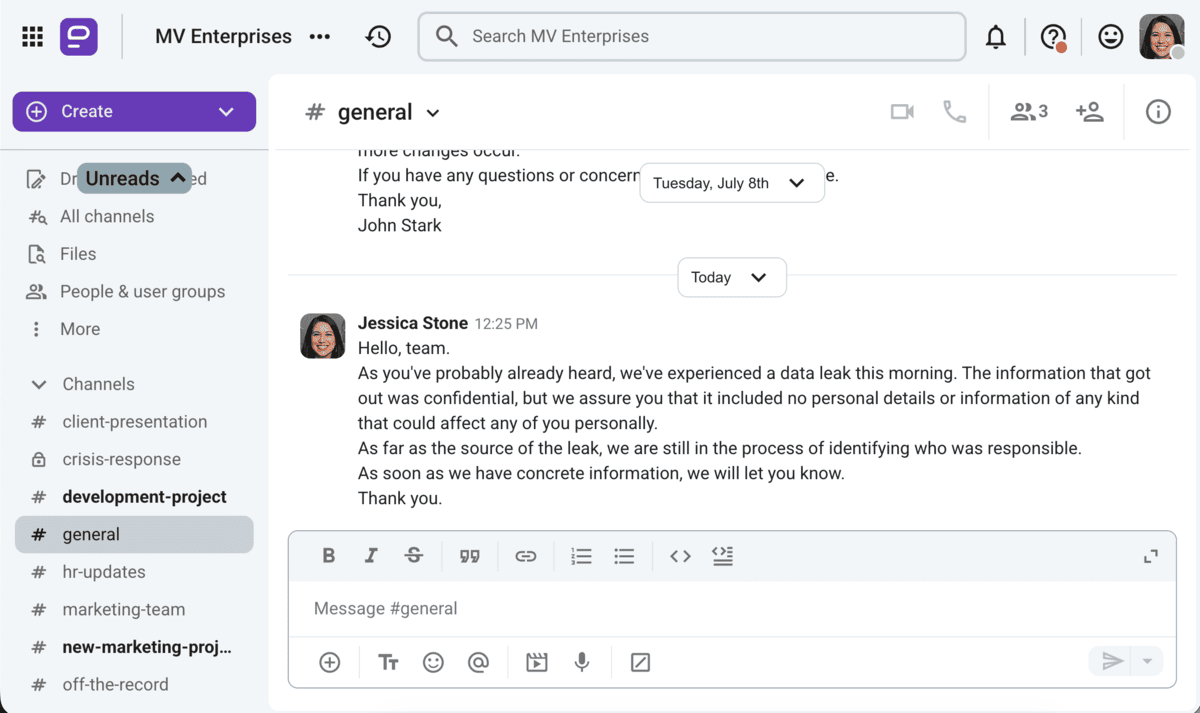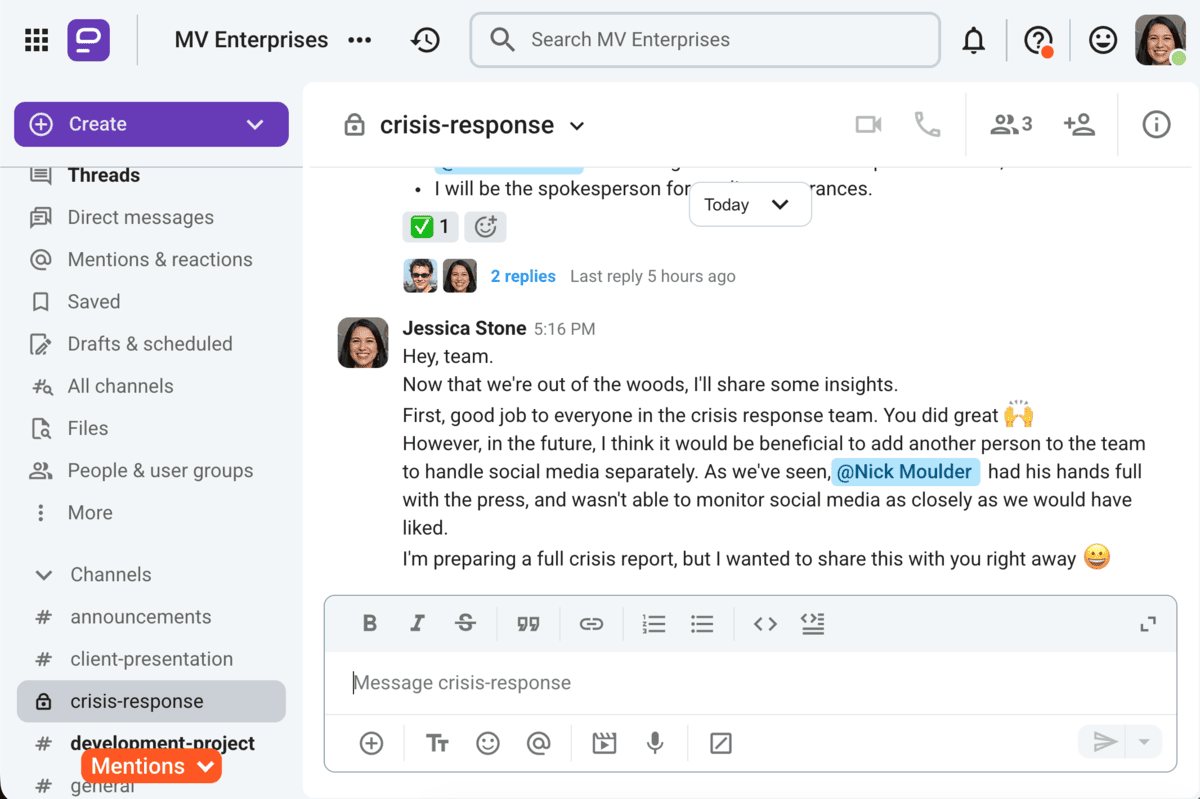No organization is immune to crises, and only those who communicate well will survive it.
Crisis communication is the structured process of managing information, emotions, and public perceptions during a critical event.
It’s not about hiding the truth or spinning a story — it’s about staying transparent, accountable, and credible when you’re faced with a crisis.
A well-prepared crisis communication plan gives your organization the clarity and ability to act fast, speak with confidence, and keep trust intact — inside and outside the organization.
Whether you’re facing a product failure, data breach, or public backlash over a campaign, what you say and how you say it can determine whether your brand recovers or collapses under pressure.
Let’s take a look at why and how you should build a strong crisis communication strategy, as well as some good and bad examples of crisis communication.

- Crisis communication is a strategic approach of handling crisis circumstances with transparent, factual, and effective communication.
- Companies that have concrete crisis communication plans save money and retain public trust in crisis situations, compared to companies without it.
- Maintaining a strong crisis communication plan is a cycle where you plan, test, evaluate, and refine it.
- Creating and maintaining a strong crisis communication plan is made possible with strong and effective team communication.
Table of Contents
The high cost of chaos: The business case for a crisis communication plan
Crises aren’t rare events, and being prepared for them will save your reputation as well as your budget.
According to PwC’s Global Crisis and Resilience Survey, 69% of organizations experienced some sort of crisis in the last 5 years.
Yet, many still treat crisis communication as an afterthought rather than a core business function. When chaos hits, the cost of being unprepared shows up fast — in lost revenue, shaken trust, and reputational damage that can take years to rebuild.
Planning pays off. In fact, companies with a prepared response team cut their costs of crisis management by roughly half compared to those without a trained team.
Unfortunately, many businesses don’t take crisis communication seriously. A report from Capterra found that 98% of business leaders who activated their crisis communication plan found it effective. However, only 49% of US businesses actually have a formal, documented plan.
That means that more than half are navigating crises without structure or strategy, relying on improvisation when stakes are the highest.
Without a defined plan:
- Internal communication breaks down,
- Media relations become reactive, and
- Mixed or incomplete messages reach stakeholders.
The result is confusion, speculation, and a loss of control over the narrative.
💡 Pumble Pro Tip
Poor communication can be costly even when there’s no crisis to be managed. To learn more about the statistics on poor workplace communication, check out our guide:
5 Core components of a crisis communication plan
A strong crisis communication plan doesn’t happen by accident — you need to build it with precision, teamwork, and strong foresight.
Here are the 5 crucial elements of a crisis communication plan.
#1: Your crisis communication team and a spokesperson
Every effective crisis communication plan starts with people — a skilled crisis response team led by a credible and competent spokesperson.
This group is responsible for:
- Managing the flow of information,
- Communicating with leadership, and
- Ensuring consistent messaging.
The team should include representatives from:
- Public relations,
- Legal team,
- Operations team, and
- HR.
This way, every angle of a crisis can be covered.
The spokesperson is the face and voice of the organization, trained to handle media pressure with confidence, clarity, and empathy. They should also be skilled in verbal communication.
That’s why it’s important to regularly hold media training and employee communication training for crisis situations — so that everyone understands their roles, responsibilities, and communication boundaries.
During a crisis, a well-prepared team reduces confusion, protects credibility, and projects calm authority — key factors in maintaining public trust and business continuity.
💡 Pumble Pro Tip
Your spokesperson should be an effective communicator. To learn more about the skills that an effective communicator must have, check out our guide:
#2: Stakeholder and media lists
Identifying and maintaining accurate stakeholder and media lists ensures that critical messages reach the right people fast. A strong crisis communication strategy defines who needs to know what and when.
Stakeholders include anyone directly or indirectly affected by the situation:
- Employees,
- Customers,
- Investors,
- Suppliers,
- Creditors, and
- The community.
Equally important are media relations contacts who can amplify your voice:
- Journalists,
- Editors,
- Social media influencers, and
- Reporters.
Keeping these lists current — with names, roles, contact details, and preferred communication channels — saves valuable time in crisis situations where every minute counts.
#3: Pre-approved messaging and holding statements
Speed matters in a crisis, but so does accuracy. Pre-approved messaging and holding statements give organizations a head start.
These are ready-to-go responses addressing likely scenarios identified through risk assessment. They strike a balance between being direct and staying cautious — acknowledging the crisis situation without speculating or assigning blame.
For example, a holding statement might:
- Confirm awareness of an incident,
- Express concern, and
- Commit to timely updates as more facts emerge.

These templates can later evolve into full press releases or internal updates as details become available.
Having pre-approved messaging helps avoid communication breakdowns and ensures consistent tone across statements.
It also gives the crisis communication team confidence to act quickly, reinforcing credibility and maintaining control over the narrative.
#4: Designated communication channels
A clear and effective crisis communication plan specifies which channels to use for which audiences.
Internal crisis communication may go through emails, intranet, or team communication tools, while public messages are relayed in press releases, official websites, and social media platforms.
The key is consistency — every channel should deliver the same verified information, aligned with your crisis communication strategy.
Choosing the right communication channel ensures a quick and effective crisis response.
Handle crisis communication easier
#5: Post-crisis review process
Once the immediate crisis has passed, the post-crisis review process begins. This is where real learning happens.
The crisis communication team should conduct a debrief to analyze:
- What worked,
- What didn’t, and
- How the crisis management plan can be improved.
You can collect and analyze feedback from stakeholders, employees, and the general public to evaluate the clarity and quality of your crisis communication.
You can also review internal communication logs and social media engagement to spot gaps or mixed messages.
The goal of the post-crisis review process is to improve continuously by refining the crisis communication strategy to strengthen business continuity and image.
Documenting lessons learned and updating communication protocols ensures your organization emerges smarter, more agile, and better prepared for the next challenge.
Streamline communication with Pumble
How to build a crisis communication plan
Now that we’ve laid down the basic elements, we can examine some practical steps that will build a healthy foundation for crisis communication.
These actions and principles span all stages of crisis management, from preparing for a potential crisis to reflecting on it.
#1: Identify potential risks and determine possible business impact
A strong crisis communication plan starts with understanding what could go wrong.
You should regularly conduct risk assessments to identify potential threats — from data breaches and supply chain disruptions to executive misconduct or natural disasters.
Once identified, evaluate how each risk could affect operations, reputation, employees, and customers.
You should also prioritize them based on likelihood and the impact they would have on your business.
This thorough analysis forms a backbone of your crisis management plan, guiding you on where to focus your resources and communication efforts.
Knowing your weak spots and vulnerabilities helps you:
- Prepare for realistic scenarios,
- Develop response strategies, and
- Anticipate problems before they arise.
Awareness and preparedness are the first line of defense in crisis communication.
#2: Prepare and practice for potential crises
Preparation beats panic. Prepare a clear crisis communication plan that clearly defines:
- Roles,
- Responsibilities, and
- Communication flows.
Ensure your crisis response team and spokesperson know exactly what to do and say under pressure.
Then, test those plans through simulations or tabletop exercises. Practicing potential crisis scenarios exposes weak spots and builds confidence in your crisis management team.
Additionally, regular media training and employee briefings keep everyone informed and prepared.
When a crisis hits, organizations that have practiced beforehand can respond faster and communicate better.
A plan that lives only on paper is useless in a real emergency situation — practicing it before a crisis makes it bulletproof.
Conduct employee training in Pumble
#3: Develop key messages
The key to a consistent and effective crisis communication strategy are clear and focused key messages.
These are the foundation of all responses — short, fact-based statements that express:
- What happened,
- What’s being done, and
- What comes next.
Key messages must reflect the organization’s values and show empathy toward those affected.
Craft your key messages around 3 principles:
- Clarity,
- Accountability, and
- Reassurance.
These 3 principles should guide everything from media interviews to customer updates and public relations efforts.
You should keep them flexible enough to adapt as new information emerges, but consistent enough to anchor the narrative.
Strong key messages cut through noise and emotion, helping your organization stay credible, human, and always in control.
#4: Establish communication protocols
Clear communication protocols keep order when everything feels chaotic.
You need to define how internal updates will move between teams, leadership, and employees. Also, do the same for external updates that will reach stakeholders, customers, and the media.
Decide:
- Who approves messages,
- Who delivers them, and
- Which communication channels are used for each audience.
These protocols should also outline escalation procedures and backup contacts in case people are unavailable.
In a real crisis, there’s no time for confusion or debate. Internal and external protocols keep your crisis communication strategy focused, efficient, and consistent.
They ensure everyone — from the spokesperson to social media managers — knows their role in maintaining transparency in communication and business continuity under pressure.
Maintain transparency with Pumble
#5: Develop a crisis communication plan
Your crisis communication plan is the blueprint for managing both information and perception during a crisis.
It should contain all the previous steps — risk assessment, team roles, messaging templates, and communication protocols — in one actionable document.
This plan should specify:
- Timelines,
- Key contacts, and
- Reporting structures.
You should also include guidance for media relations, public relations, and internal communication, so every group understands how to align their responses.
The plan should also integrate with your broader crisis management plan to ensure seamless coordination between operational and communication efforts.
If you build your crisis communication plan thoughtfully and test it regularly, it becomes a living tool that guides real-time decision making when stakes are highest — not just a file on a shared drive that’s forgotten about in times of crisis.
💡 Pumble Pro Tip
For a detailed guide to building a crisis communication plan, along with pre-prepared templates, check out our post:
#6: Steal the thunder
In crisis communication, silence can be fatal.
Stealing the thunder means getting ahead of the story — being the first to acknowledge the issue before rumors or media leaks define it for you.
This proactive communication approach will show accountability, transparency, and control. It also builds credibility with stakeholders and the public.
The key is to act fast with accurate facts, not speculation.
When you share information early, before anyone else can manipulate the narrative, you gain control of the situation.
#7: Stick to the facts
In any crisis, credibility is your most valuable asset, and facts are its foundation.
To stay credible, you need to avoid:
- Speculation,
- Exaggeration, and
- Giving promises you can’t keep.
Always stick to verified information, even if it sometimes means simply admitting: “We don’t have that information yet.”

When you only present fact-checked information, you build credibility and trust with stakeholders and the public, while rumors and hasty assumptions undermine your crisis communication strategy instantly.
A calm and fact-focused approach also supports legal and compliance integrity within your broader crisis management plan.
To avoid being too cold and harsh, pair your fact-based approach with a tone of empathy and accountability to humanize your message.
In crisis situations, calm and truthful communication becomes the anchor that preserves both reputation and business continuity.
#8: Be consistent in your crisis communication
Consistency builds credibility. During a crisis, every message should align — whether it’s a press release, an internal business memo, or a social media post.
Conflicting statements cause confusion and damage trust.
That’s why you should make sure to establish a unified tone and message throughout your communications. Your tone should reflect empathy, accountability, and transparency.
The crisis response team and spokesperson should work closely together to ensure all communications share the same verified facts and approved phrasing and tone.
Consistency also applies to timing — regular, predictable updates reassure stakeholders that the organization is in control.
When everyone, internally and externally, hears the same story, it strengthens the narrative and supports long-term business continuity and crisis recovery.
#9: Monitor and respond in real time
Crisis communication doesn’t end once you send out your initial message — it’s a live process.
Continuous monitoring allows your crisis response team to track:
- Media coverage,
- Social sentiment, and
- Stakeholder reactions as events unfold.
Use social listening tools, feedback channels, and direct reports from employees or customers to gauge responses and identify miscommunication early. Quick and thoughtful responses during a crisis demonstrate transparency and engagement from your organization.
Your crisis response team should be ready to correct inaccuracies, issue updates, and adjust messages as facts develop.
Real-time monitoring keeps your organization agile and in control, preventing small problems from escalating into full-blown reputational damage.
See the power of instant communication
#10: Review and revise plans
Crisis plans should never collect dust.
Regular reviews and revisions keep your crisis communication plans relevant as your business, risks, and technologies evolve.
Schedule updates at least annually — and definitely after a real or simulated crisis.
As part of your review process, you should:
- Check that contact lists, holding statements, and media databases are accurate and up-to-date,
- Collect and use feedback from employees, stakeholders, and leadership to identify gaps or unclear procedures, and
- Revise the crisis communication plan to reflect the new lessons learned.
A review process reinforces your commitment to continuous improvement of your communication protocols.
The most resilient organizations treat crisis planning as a cycle — plan, test, evaluate, refine — not a one-time task.
3 Stages of crisis communication
Before you go ahead and make your own crisis communication plan, it’s a good idea to learn more about how exactly crisis communication works.
Timothy Coombs, the author of the Situational Crisis Communication Theory, identifies 3 distinct phases of crisis communication:
- The pre-crisis phase,
- The crisis response phase, and
- Post-crisis communication.
Each stage carries distinct demands for collecting and interpreting information and then distributing that knowledge, so it’s important to examine them separately.
#1: The pre-crisis phase
The fact that a crisis hasn’t occurred yet doesn’t prevent organizations from planning and preparing for that eventuality.
The activities in the pre-crisis phase focus on two areas — prevention and preparation.
The prevention of a potential crisis is reflected in the attempts to reduce risks by identifying emerging developments and issues that could escalate into a crisis.
Early identification of such issues allows organizations to analyze and strategize their response.
In terms of communication, the detection of potential crises allows organizations to communicate the risks with the stakeholders, thus preparing them for worst-case scenarios and demonstrating a sense of control and competence.
Preparing for a potential crisis can only go to a certain extent, due to the unpredictable nature of many situations. This means that organizations can only identify and plan for a limited number of specific scenarios.
However, planning and preparation don’t need to be related to concrete scenarios.
There are many general steps and actions that organizations can take to prepare to respond to a potential crisis.
When choosing a more flexible planning approach, here are the steps organizations could take:
- Form a response team,
- Designate a spokesperson,
- Ensure effective communication among employees (by using internal communication software, for example),
- Formulate procedures and guidelines, and
- Provide specific training (communication skills, crisis management, etc.) for relevant individuals.
#2: The crisis phase
This is where plans meet reality. Information is moving fast, emotions are high, and decisions matter.
The focus in the initial phase of the crisis is quick, factual, and empathetic communication.
The spokesperson and crisis communication team must act decisively by:
- Confirming facts,
- Issuing updates, and
- Staying ahead of rumors and grapevine communication.
As the crisis continues and its immediate effects subside, the focus of communication can shift from addressing the crisis itself to addressing its implications.
This type of communication usually involves expressions of sympathy and announcements of any corrective actions to prevent the crisis from reoccurring.
Consistency and clarity are critical to maintaining credibility and control of the narrative.
#3: The post-crisis phase
Communication should not cease once a crisis is considered resolved, as its consequences can linger long after its conclusion.
Post-crisis communication represents an extension of previous communication activities coupled with the lessons learned from the crisis.
The post-crisis stage focuses on recovery, learning, and rebuilding trust.

As an organization exits the period of crisis and attempts to revert to its usual operations, employees and stakeholders will want to know the following:
- When things will go back to normal,
- What this normalcy will look like,
- How the crisis has impacted the organization, and
- What steps the organization will take to prevent the crisis from happening again.
Crisis communication examples: Lessons from the best (and worst)
Real-world examples show how these principles and steps of a crisis communication play out under pressure.
Let’s take a look at some examples of effective crisis communication, and some where poor communication made things worse.
Good crisis communication examples
When COVID-19 brought global travel to a halt, Marriott International, a lodging franchise, faced one of its toughest moments in history. They opted for an unconventional way of addressing the crisis.
Instead of issuing a standard press release, CEO Arne Sorenson spoke directly to employees, stakeholders and the public through a video message — a move that’s still relatively uncommon for corporate leaders.
The video stood out for its honesty and vulnerability. Sorenson, visibly emotional, explained Marriott’s challenges, the difficult layoffs ahead, and the company’s commitment to its people.
The format made the message deeply personal and credible — showing that in times of crisis, sincerity is always a good strategy.
Another good example of good crisis communication comes from American Airlines. Namely, when a tragic accident involving one of its aircrafts occurred in 2025, the airline company acted swiftly and sincerely.
The CEO issued a heartfelt public statement within hours of the incident, expressing condolences and committing to full transparency as investigations unfolded.
The company kept stakeholders, employees, and the public informed through consistent updates and verified facts. Their approach balanced empathy with accountability — a hallmark of strong crisis management planning.
💡 Pumble Pro Tip
The examples of good crisis management contain principles of positive communication. To learn more about positive and negative communication in the workplace, read our blog post:
Bad crisis communication examples
In 2025, American Eagle launched their “Great Jeans” campaign featuring actress Sydney Sweeney, with the tagline “Sydney Sweeney has great jeans.”
What began as a playful copy triggered accusations of insensitive messaging around eugenics and identity.
The brand’s initial response — “It’s about the jeans” — felt dismissive and lacked acknowledgment of the criticism. Rather than steering the narrative proactively, they missed the moment and allowed backlash to grow.
This illustrates how ignoring your community and failing to engage transparently weakens credibility and stakeholders’ trust.
Another example of bad crisis communication comes from Nestlé. Despite mounting evidence that they continued large-scale use of single-use plastics, Nestlé launched a high-profile sustainability campaign touting plastic reduction.
Once journalists exposed the disparity, the company’s response was slow and formulaic — a general statement of commitment, but lacking concrete facts or accountability.
The result — the public saw an organization that was promising one thing, and doing the exact opposite.
💡 Pumble Pro Tip
Another bad way of dealing with a crisis is staying silent and passive. To learn more about passive communication in the workplace, and why it’s detrimental to your organization, check out our guide:
Your digital command and crisis center — Pumble
A plan on paper is useless in a real-time crisis. When messages are flying, emotions are high, and the clock is ticking, you need a digital command center — a central hub where your crisis communication team can coordinate quickly and confidently.
That’s where Pumble by CAKE.com comes in. Pumble is a team communication and collaboration tool that ensures quick and effective communication, both internally and externally.
Let’s see exactly how Pumble can help you in times of crisis.
Channels for your crisis team
When a crisis hits, clarity and speed matter most.
Creating a private Pumble channel (for example #crisis-response) allows your crisis response team to convene instantly, share verified updates, and assign responsibilities — all without drowning in a confusing email chain.

The ability to post updates and react in real time keeps communication flowing smoothly, ensuring leadership and crisis teams stay aligned on every decision.
Unlimited message history for a single, verifiable source of truth
In a high-pressure moment, misinformation spreads quickly.
Pumble’s unlimited message history and searchable records make it an ideal single source of truth during a crisis.
Every message, decision, and document is automatically saved, creating a complete, time-stamped record that can be reviewed later for post-crisis analysis, accountability, and even legal protection.

This transparent record helps maintain trust inside and outside the organization while ensuring everyone operates from the same set of verified facts.
Read-only announcements channels for controlled messaging
Once your team is aligned internally, you need a consistent way to communicate with the wider team or communicate across the organization.
You can do this by setting up a read-only #announcements channel in Pumble that lets you share updates without the noise of replies or speculation.
It ensures clear, consistent communication that reaches all employees fast, reducing confusion and preventing rumors before they spread.
This structured, top-down communication approach reinforces control and confidence when your organization needs it most.
Crisis communication — powered by Pumble
Effective crisis communication isn’t just about planning — it’s about acting fast, staying factual, and keeping everyone on the same page.
That’s where having the right communication tools makes all the difference.
With Pumble, teams can:
- Communicate and coordinate securely,
- Share updates in real time, and
- Maintain a single source of truth throughout any crisis.
Ready to strengthen your crisis communication strategy and tools?








